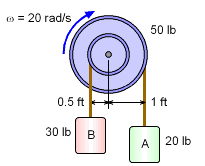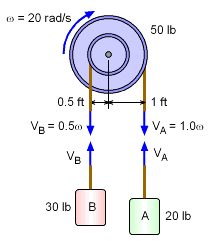| Ch 7. Rigid Body Energy Methods | Multimedia Engineering Dynamics | ||||||
| Rot. Work & Energy | Conservation of Energy | ||||||
| Rotational Kinetic Energy and Work | Case Intro | Theory | Case Solution | Example |
| Chapter |
| - Particle - |
| 1. General Motion |
| 2. Force & Accel. |
| 3. Energy |
| 4. Momentum |
| - Rigid Body - |
| 5. General Motion |
| 6. Force & Accel. |
| 7. Energy |
| 8. Momentum |
| 9. 3-D Motion |
| 10. Vibrations |
| Appendix |
| Basic Math |
| Units |
| Basic Dynamics Eqs |
| Sections |
| eBooks |
| Dynamics |
| Fluids |
| Math |
| Mechanics |
| Statics |
| Thermodynamics |
| ©Kurt Gramoll |
|
|
||
 Pulley with Two Weights |
Example |
|
|
A 50 lb pulley has two weights, A and B, attached at different distances from the center. If the pulley has an angular velocity of 20 rad/s, what is the total kinetic energy of the whole system? Assume the radius of gyration of the pulley is 0.6 ft. |
||
| Solution |
||
|
|
The total kinetic energy is the sum of the kinetic energy of each of the three parts. 1. Kinetic energy of the pulley: 2. Kinetic energy of mass A 3. Kinetic energy of mass B T = T1 + TA + TB = 111.8 + 124.2 + 46.59 T = 282.6 ft lb |
|
Practice Homework and Test problems now available in the 'Eng Dynamics' mobile app
Includes over 400 free problems with complete detailed solutions.
Available at the Google Play Store and Apple App Store.
